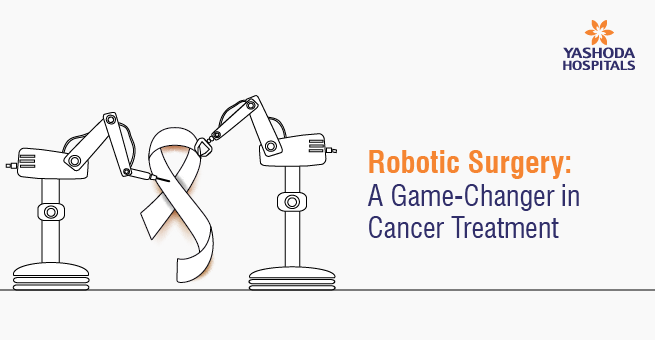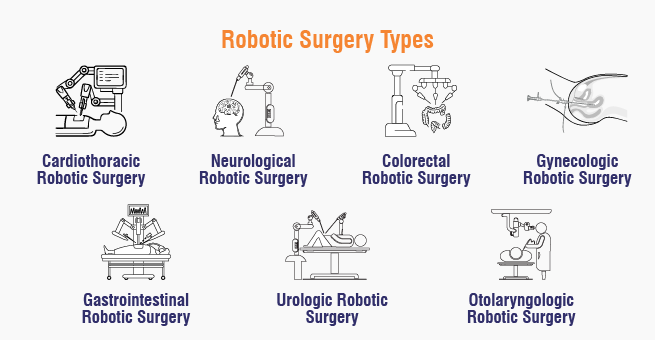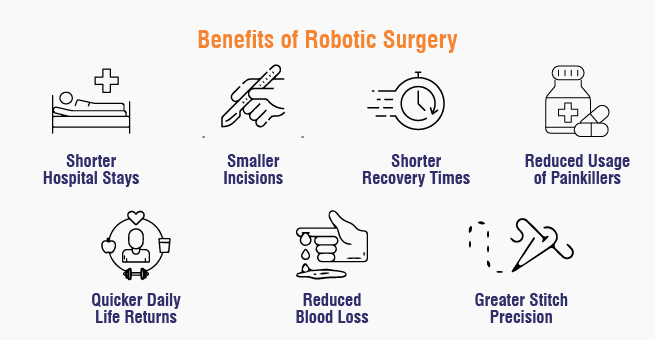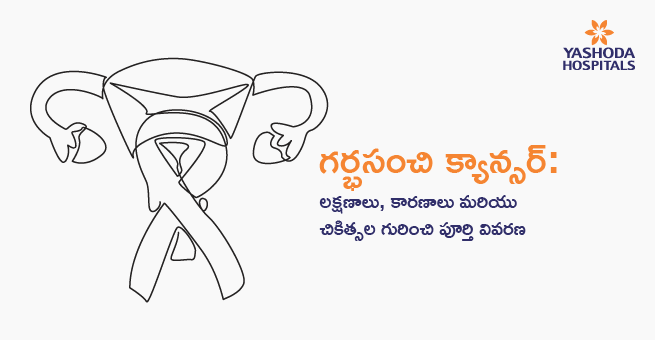Robotic Surgery: A Game-Changer in Cancer Treatment

The treatment of cancer has been completely transformed by robotic surgery, thus leading to numerous advantages over conventional open surgery. Due to its accuracy, lesser invasiveness, and better patient outcomes, it is the technique of choice for many types of cancer. In robotic surgery, there is a trained doctor who operates a robotic platform with miniaturized surgical tools and an HD camera. The surgeon operates the robotic arms with even more precision, enabling a higher degree of complexity in procedures.
What is Robotic Surgery for Cancer Treatment?
Robotic surgery entails employing specially-trained surgeons to extract cancerous cells through robotic technology consisting of minute devices and a computer console. Traditional open surgery may not be the best option for certain types of cancer, and robotic cancer treatment is specifically designed to remove the cancer. In this technique, surgeons operate on the patient’s body through surgical robotic tools that have been designed to resemble human hands, with one arm fitted with a laparoscope while others grip small instruments. The doctor is seated before a screen displaying three-dimensional images of the tumor and manipulates each robotic arm using a joystick that imitates wrist and hand movements, thus promoting flexibility. Surgeons are responsible for robotic operations rather than robots.
In cancer surgery, the doctors work hard to make sure that they are able to remove it completely and do not leave behind any traces of it so that the patient can heal fast without facing challenges from it. Cancer type, stage, and prospects also impact a lot on surgical objectives. Robotic surgery may be considered an option, determined by the surgeon, and it is still open, despite being considered an alternative to other types of surgery.
Robotic Cancer Surgery in India: An Expanding Field
In the battle against cancer, hospitals in India have started embracing robotic surgical techniques as they incorporate cutting-edge robotics and mirroring intelligence systems. The introduction of advanced technologies has led to numerous advantages, such as access to highly trained surgeons capable of performing highly technical operations, affordable treatment in comparison to payment rates offered by Western nations, and complete service encompassing all aspects of cancer management like diagnosis, therapy, and recovery. Integrated cancer care is available in many hospitals, thereby reducing expenses incurred by this illness.
The most common robotic surgery procedures in India for various cancers include prostate, kidney, lung, gynecological, cervical, colorectal, head and neck, and pancreatic cancer.
Types of Robotic Surgery
Some of the primary types of robotic surgeries based on surgical specialties include:
- Cardiothoracic robotic surgery
- Neurological robotic surgery
- Colorectal robotic surgery
- Gynecologic robotic surgery
- Gastrointestinal robotic surgery
- Urologic robotic surgery
- Otolaryngologic robotic surgery and more
In general, some of the most common robotic surgery procedures that are commonly performed are:
- Robotic surgery for lung cancer: Robotic-assisted lobectomy, also called robotic surgery for lung cancer, is a minimal robotic procedure used to remove the cancerous lobe of the lung.
- Robotic prostate cancer surgery: The minimally invasive surgery that entails getting rid of the prostate and other nearby tissues is known as robotic-assisted radical prostatectomy. The prostate cancer robotic surgery success rate is generally high in the majority of cases.
- Robotic-assisted nephrectomy: Robotic-assisted nephrectomy, a treatment for kidney tumors, is a surgical method of removing them.
- Robotic-assisted cystectomy: The robotic-assisted cystectomy is one of the types of minimally invasive surgery for bladder removal. It is designed mainly for advanced bladder cancer that has invaded the muscle wall.
- Robotic-assisted hysterectomy: A hysterectomy conducted with robotic assistance is one of the least intrusive surgical operations aimed at getting rid of the malignant uterus. In this procedure, robot technology increases a surgeon’s accuracy and command throughout the process.
- Robotic-assisted hepatectomy: Robotic-assisted hepatectomy is a minimally invasive procedure that involves the removal of a portion of the liver.
- Robotic-assisted thyroidectomy: A robotic-assisted thyroidectomy is a type of surgical operation that has a less invasive approach.
In addition to the above procedures, there are some more robotic surgeries that have come into use.

What are the Benefits of Robotic Surgery?
There are several benefits of robotic surgery which include:
- Shorter hospital stays.
- Smaller incisions.
- Shorter recovery times.
- Reduced narcotic painkillers.
- Quicker daily life returns.
- Reduced blood loss.
- Greater stitch precision.
Apart from these, a few more advantages of robotic surgery are also there, which include:
- Two high-definition cameras for magnified surgical site views.
- An additional arm for holding surgical instruments for increased operating capability.
- Instant image referencing for the display of diagnostic images.
- Enhanced near-infrared imaging for real-time blood flow evaluation.
- Extra mobile “wrist action” for holding specialized surgical instruments.
- Scalability for calibrating the arm to move a fraction of an inch for every inch of hand movement.
- Simplifies complex movements like delicate removals and suturing.

Robotic Surgery Pros and Cons
Pros of robotic surgery:
- Provides 3D vision
- Visualizes complex anatomical areas
- Enhances dexterity and endo-wrist movement
- Scaling of motion and improved ergonomics
- Improved post-op recovery and functional outcomes
Cons of robotic surgery:
- Anesthetic challenges
- Lack of haptic feedback
- Extended surgery duration
- Increased cost
Experience the accuracy and care that surgery provides!
Robotic Surgery Risks and Complications
Possible robotic surgery risks include:
- The surgeon may switch to open surgery if unexpected issues occur.
- There is a small chance of bleeding, blood clots, infection, and other complications.
- Can last as long as regular surgery, especially for common procedures.
Robotic Surgery vs. Traditional Surgery
Robotic surgical and classic surgical techniques for cancer treatment differ from one another. Though both aim at treating health issues, they use different mechanisms that make them vary a lot with regard to their practice, accuracy level, and results.
- Robotic surgery employs small cuts for its minimally invasive techniques that provide more control for the surgeon by an instrumented robot as well as better visibility of the area being operated on with a more detailed, clearer, and larger-than-life image of that specific place.
- Whereas traditional or open surgery is characterized by different aspects, including large cuts, direct manipulation by the surgeon themselves, and limited visualization, which makes it harder for surgeons to have a practical view of the surgical field and therefore physically access the area of operation.
Concerned about your treatment options?
Robotic Surgery Recovery Time
Robotic surgery patients generally experience shorter recovery times compared to traditional open surgery due to smaller incisions. Factors affecting recovery time include the type of surgery, overall health, and adhering to post-operative care. Complex and prolonged procedures can impact recovery time, while patients with underlying health conditions may have longer recovery periods.
Robotic Surgery Success Rate
Robotic surgery has shown promising results in various fields, including urology, gynecology, general surgery, cardiology, and thoracic surgery. However, success rates can vary based on factors like surgery type, surgeon experience, and patient health. Common areas of successful robotic surgery includes prostate, kidney, bladder cancer, hysterectomy, fibroid removal, general surgery, and more.
Conclusion
Yashoda Hospitals, a leading hospital in Telangana and Andhra Pradesh, has become the first to implement robotic surgery at the Institute of Robotic Sciences in Hyderabad. The hospital also performed the first robotic kidney transplant in the state. The institute has performed the most successful robotic surgeries in the Telangana region. Yashoda Cancer Institute uses robotic sciences for advanced oncology procedures, collaborating with medical and radiation oncology departments for comprehensive patient care.
Our Institute of Robotic Sciences has introduced the da Vinci surgical system, a revolutionary minimally invasive surgery tool. This system uses advanced robotic technology to scale, filter, and translate surgeon commands into precise micro-instrument movements, enhancing surgical capabilities and enabling complex surgeries through small incisions with unmatched precision. This system promotes improved medical outcomes and greater patient safety.
Have any questions or concerns about your health? We’re here to help! Call us at +918929967127 for expert advice and support.
About Author –



















 Appointment
Appointment WhatsApp
WhatsApp Call
Call More
More

